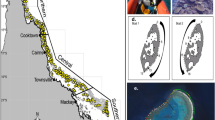Abstract
Understanding long-term variability in the occurrence of tropical cyclones that are of extreme intensity is important for determining their role in ecological disturbances1,2,3,4,5, for predicting present and future community vulnerability and economic loss6 and for assessing whether changes in the variability of such cyclones are induced by climate change7. Our ability to accurately make these assessments has been limited by the short (less than 100 years) instrumented record of cyclone intensity. Here we determine the intensity of prehistoric tropical cyclones over the past 5,000 years from ridges of detrital coral and shell deposited above highest tide and terraces that have been eroded into coarse-grained alluvial fan deposits. These features occur along 1,500 km of the Great Barrier Reef and also the Gulf of Carpentaria, Australia. We infer that the deposits were formed by storms with recurrence intervals of two to three centuries8,9,10,11, and we show that the cyclones responsible must have been of extreme intensity (central pressures less than 920 hPa). Our estimate of the frequency of such ‘super-cyclones’ is an order of magnitude higher than that previously estimated (which was once every several millennia12,13,14), and is sufficiently high to suggest that the character of rainforests and coral reef communities were probably shaped by these events.


Similar content being viewed by others
References
Connell, J. Diversity in tropical rainforests and coral reefs. Science 199, 1302–1310 (1978).
Sousa, W. The role of disturbance in natural communities. Annu. Rev. Ecol. Syst. 15, 353–391 (1984).
Tanner, J. et al. The role of history in community dynamics: A modelling approach. Ecology 77, 108–117 (1996).
Hughes, T. & Connell, J. Multiple stressors on coral reefs: A long-term perspective. Limnol. Oceanogr. 44, 932–940 (1999).
Connell, J. et al. A 30 year study of coral abundance, recruitment and disturbance at several scales in space and time. Ecol. Monogr. 67, 461–488 (1997).
Oliver, J. & Britton, N. Natural Hazards and Reinsurance (Cumberland College Health Sciences, Sydney, Australia, 1989).
Walsh, K. et al. Climate Change in Queensland under Enhanced Greenhouse Conditions (Third annual report 1999–2000, CSIRO Atmospheric Research, Aspendale, Victoria, Australia, 2001).
Chappell, J. et al. Holocene palaeo-environmental changes, central to north Great Barrier Reef inner zone. BMR J. Aust. Geol. Geophys. 8, 223–235 (1983).
Chivas, A. et al. Radiocarbon evidence for the timing and rate of island development, beach rock formation and phosphatization at Lady Elliot Island, Queensland, Australia. Mar. Geol. 69, 273–287 (1986).
Hayne, M. & Chappell, J. Cyclone frequency during the last 5,000 yrs from Curacoa Island, Queensland. Palaeogeogr. Palaeoclimatol. Palaeoecol. 168, 201–219 (2001).
Hayne, M. & Chappell, J. A record of cyclone frequency from Princess Charlotte Bay, Nth Qld, Australia. Palaeogeogr. Palaeoclimatol. Palaeoecol. (in the press).
Lourensz, H. Tropical cyclones in the Australian region, July 1909 to June 1980. (Bureau of Meteorology, Melbourne, 1981).
Harper, B. Storm Tide Threat in Queensland: History, Prediction and Relative Risks (Technical report 10, Queensland Department of Environment & Heritage, Brisbane, 1998).
McInnes, K. et al. Cyclones Impacts on Tourism, Cairns, Nth Queensland (CSIRO Report, CSIRO Tourism, Melbourne, 2000).
Hubbell, S. et al. Light gap disturbances, recruitment limitation, and tree diversity in a neotropical rainforest. Science 283, 554–557 (1999).
Bryant, E. Natural Hazards (Cambridge Univ. Press, Cambridge, 1991).
Henderson-Sellers, A. et al. Tropical cyclones and global climate change; a post IPCC assessment. Bull. Am. Meteorol. Soc. 79, 19–38 (1998).
Blumenstock, D. Typhoon effects at Jaluit Atoll in the Marshall Islands. Nature 182, 1267–1269 (1958).
Maragos, J. et al. Tropical cyclone creates a new land formation on Funafuti Atoll. Science 181, 1161–1164 (1973).
Fitchett, K. Physical effects of Hurricane Bebe upon Funafete Atoll, Tuvalu. Aust. Geographer 18, 1–7 (1987).
Scoffin, T. The geological effects of hurricanes on coral reefs and the interpretation of storm deposits. Coral Reefs 12, 203–221 (1993).
Chappell, J. & Grindrod, J. in Coastal Geomorphology in Australia (ed. Thom, B.) 197–231 (Academic, Sydney, 1984).
Everham, E. & Brokaw, N. Forest damage and recovery from catastrophic wind. Bot. Rev. 62, 113–184 (1996).
Hughes, T. Community structure and diversity of coral reefs: The role of history. Ecology 7, 275–279 (1989).
Lirman, D. & Fong, P. Susceptibility of coral communities to storm intensity, duration and frequency. Proc. 8th Int. Coral Reef Symp. (eds Lessios, H. & MacIntire, I.) Vol. 1, 561–566 (Smithsonian Tropical Research Institute Balboa, Panama, 1997).
Potts, D. C. et al. Dominance of a coral community by the genus Porites. Mar. Ecol. Prog. Ser. 23, 79–84 (1985).
Hubbert, G. & McInnes, K. A storm surge inundation model for coastal planning and impact studies. J. Coast. Res. 15, 168–185 (1999).
Sanderson, B. et al. A Tropical Cyclone Maximum Envelope of Waters (MEOW) Technique (Applied Mathematics Report 95/28, Department of Mathematics, Monash Univ. Clayton, Victoria, Australia, 1995).
US Army Corps of Engineers Shore Protection Manual (US Army Coastal Engineering Research Centre, Washington, 1986).
Acknowledgements
We thank J. Wright, J. Tanner and H. Marsh for comments on the manuscript; T. Hughes, J. Chappell, G. Hubbert and S. Oliver for discussions on the topic; and J. H. Choat and R. Pearson for early encouragement of this project. M.H. publishes with the permission of the Chief Executive Officer of AGSO.
Author information
Authors and Affiliations
Corresponding author
Rights and permissions
About this article
Cite this article
Nott, J., Hayne, M. High frequency of ‘super-cyclones’ along the Great Barrier Reef over the past 5,000 years. Nature 413, 508–512 (2001). https://doi.org/10.1038/35097055
Received:
Accepted:
Issue Date:
DOI: https://doi.org/10.1038/35097055
- Springer Nature Limited
This article is cited by
-
A long-term view of tropical cyclone risk in Australia
Natural Hazards (2023)
-
Stormier mid-Holocene southwest Indian Ocean due to poleward trending tropical cyclones
Nature Geoscience (2022)
-
Generation of a global synthetic tropical cyclone hazard dataset using STORM
Scientific Data (2020)
-
Geospatial modeling of environmental hazards to coral reefs in the Oman Sea
Coral Reefs (2020)
-
Mapping of cyclone induced extreme water levels along Gujarat and Maharashtra coasts: a climate change perspective
Climate Dynamics (2020)





